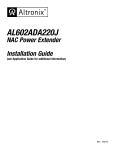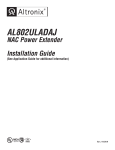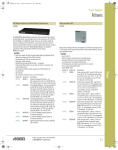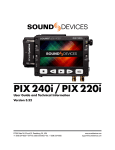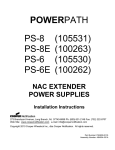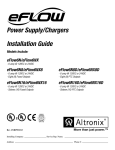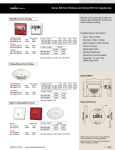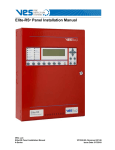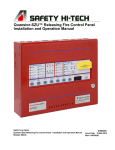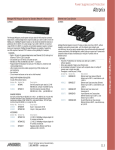Download Altronix AL602ULADA Installation guide
Transcript
AL602ULADA NAC Power Extender Installation Guide (see 02 Application Guide for additional information) Altronix Corp. 140 58th St. Brooklyn, NY Rev. 042209 AL602ULADA - NAC Power Extender Overview: The Altronix AL602ULADA is an extremely cost effective 6.5 amp remote power supply/battery charger. It may be connected to any 24 volt Fire Alarm Control Panel (FACP). Primary applications include Notification Appliance Circuit (NAC such as strobes and horns) expansion support to meet ADA requirements. It also provides auxiliary power to support system accessories. The unit delivers electronically regulated and filtered 24 volt power to Class B, Style W, X, Y or Class A, Style Z NAC loop circuits. Additionally, a separate 1.0A auxiliary output for four (4)-wire smoke detectors is available. The 6.5 amp max. alarm current can be divided between the four (4) outputs for powering NAC devices. Each output is rated at 2.5 amp max., and can be independently programmed for Steady, Temporal Code 3 or Strobe Synchronization. All outputs may be programmed for Input to Output Follower Mode (output will follow input). An individual output of 4 amp is achieved by paralleling 2 outputs. In non-alarm condition independent loop supervision for Class A, Style Z and/ or Class B, Style W, X, Y FACP NAC circuits is provided. In the event of a loop trouble, the FACP will be notified via the steered input (input 1 or input 2). In addition, there are common trouble output terminals (NC, C, NO) which are used to indicate general loop/system trouble. A common trouble input is provided for optional NC (normally closed) devices to report trouble to the FACP. Two (2) FACP signaling outputs can be employed and directed to control supervision and power delivery to any combination of the four (4) outputs. Specifications: Agency Listings: • UL Listed Control Units and Accessories for Fire Systems (UL 864). • MEA - NYC Department of Buildings Approved. • CSFM - California State Fire Marshal Approved. • FM - Factory Mutual Approved. • NFPA 72 Compliant. Input: • Power input 120VAC 60 Hz, 4 amp. • Two (2) Class A, Style Z or two (2) Class B, Style W, X, Y FACP inputs. • Two (2) NC dry contact trigger inputs. Output: • 24VDC @ 6.5 amp max total alarm current. • 2.5 amp max current per output. • Separate 1.0 amp auxiliary output. • Two (2) outputs may be paralleled for more power on an indicating circuit (see 02 Application Guide). • Programmable supervised indicating circuit outputs: Four (4) Class B, Style W, X, Y or Two (2) Class A, Style Z or One (1) Class A, Style Z and Two (2) Class B, Style W, X, Y (see 02 Application Guide). • Thermal and short circuit protection with auto reset. Battery Backup: • Charging voltage is 26.2-26.4VDC. • Built-in charger for sealed lead acid or gel type batteries. • Automatic switchover to stand-by battery when AC Fails. • Zero voltage drop when switching over to battery backup. Supervision: • AC fail supervision (form “C” contact, 1 amp / 28VDC). Factory set for 30 seconds with optional 2.5 to 3 hour delay setting (field selectable). Supervision (cont’d): • Instant local AC trouble reporting relay (form “C” contact, 1 amp / 28VDC). • Battery presence and low battery supervision (form “C” contact, 1 amp / 28VDC). Visual Indicators: • Input and output status LED indicators. Special Features: • 2-wire horn/strobe Sync mode allows audible notification appliances (horns) to be silenced while visual notification appliances (strobes) continue to operate. • Sync protocols include Potter/Amseco, Faraday, Gentex®, System Sensor®, and CooperWheelock®. • Temporal Code 3, Steady Mode, Input to Output Follower Mode (maintains synchronization of notification appliances circuit). • Compatible with 12VDC or 24VDC fire panels. • Output loop supervision steered to input 1 or input 2. • Signal circuit trouble memory (helps identify intermittent loop problems). • Common trouble input and output for external trouble signals tie-in. • Ground fault detection. • Unit includes power supply, red enclosure, cam lock, and battery leads. Enclosure Dimensions (approx. H x W x D): 15.5” x 12” x 4.5” (393.7mm x 304.8mm x 114.3mm). WARNING: To reduce the risk of fire or electric shock, do not expose the unit to rain or moisture. This installation should be made by qualified service personnel and should conform to all local codes. - 2 - AL602ULADA Power Supply Specifications: AC Input: 120VAC 60Hz, 4 amp. Output: Four (4) regulated supervised NAC output circuits, 24VDC, 2.5 amp maximum current. One (1) aux. special application 24VDC power output circuit 1 amp, non-supervised total output current must not exceed current 6.5 amp in Alarm Condition. Battery Use two (2) 12VDC / 7AH, two (2) 12VDC / 12AH or two (2) 12VDC / 40AH batteries connected in series. Stand-by/Alarm Current Consumption: 90mA/175mA EOL Resistor (end of line): 2.2K (2200 ohm), Altronix Model # AL-EOL22 (included). Ground fault maximum test impedance: 1000 ohm. Stand-by Specifications: Stand-by Batteries Stand-by Time Total Amp/Minutes Alarm Output Current Aux. Output 24VDC/7AH 24 Hours 6.5 amp/5 minutes --- 24VDC/12AH (use two (2) 12VDC batteries in series) 24 Hours 6.5 amp/5 minutes 50mA 24VDC/40AH 24 Hours 6.5 amp/5 minutes 1 amp Note: Unit is equipped with 1 amp max. auxiliary output: “AUX” will remain battery backed up during power outage. For loads connected to “AUX” please refer to battery “Stand-by Specifications” above for ratings. When loads are connected to “AUX” output during alarm condition, the remaining outputs may not exceed 6.5 amp total alarm current (example: AUX = 1 amp, outputs up to 5.5 amp). Installation Instructions: Wiring methods shall be in accordance with the National Electrical Code/NFPA 70/NFPA 72/ ANSI, and with all local codes and authorities having jurisdiction. ground Product is intended for indoor dry use only. Carefully review: Application Guide for AL602ULADA, AL802ULADA, AL1002ULADA Power Supply Specifications (pg. 3) L N line Stand-by Specifications (pg. 3) neutral Output Programming Selection Table (pg. 4) Sync Mode Selection Table (pg. 4) Terminal Identification Table (pgs. 5-6) Fig. 1 LED Status Indication Table (pg. 6) 1.Mount the unit in the desired location. Mark and predrill holes in the wall to line up with the top two keyholes in the enclosure. Install two upper fasteners and screws in the wall with the screw heads protruding. Place the enclosure’s upper keyholes over the two upper screws; level and secure. Mark the position of the lower two holes. Remove the enclosure. Drill the lower holes and install two fasteners. Place the enclosure’s upper keyholes over the two upper screws. Install the two lower screws and make sure to tighten all screws (Enclosure Dimensions, pg. 12). Secure enclosure to earth ground (Fig. 1, pg. 3). Small terminal block wire gauges range from 16 AWG to 24 AWG, all others range from 14 AWG to 24 AWG. 2.Connect the line (L) and neutral (N) terminals to a separate unswitched AC circuit (120VAC, 60Hz) dedicated to the Fire Alarm System. 3. Measure output voltage before connecting devices.This helps avoiding potential damage. 4. Connect battery to the terminals marked [+ BAT -- ] on the Power Supply Board (battery leads included). Use two (2) 12VDC batteries connected in series. 5. Set output selection switches marked [OUT1 through OUT4] to follow corresponding input [IN1 & IN2] and desired output signal type (Output Programming Selection Table, pg. 4). 6. Connect FACP output to the desired AL800LGK9E logic board inputs, and notification appliances to the desired AL800LGK9E logic board outputs (see 02 Application Guide). AL602ULADA -3- Note: The 2-wire horn/strobe sync mode will only synchronize horns, horn/strobes, strobes with synchronization capability. 7. For connection of smoke detectors, digital dialer (see Hookup Diagram, pg. 7). Class A, Style Z Class B, Style W, X, Y, SW1 & SW2 Settings: • For all Class B, Style W, X, Y, hookups SW1 & SW2 on the AL800LGK9E logic board must be open. For all Class A, Style Z hookups SW1 & SW2 on the AL800LGK9E logic board must be closed. Output Programming Selection Table: Outputs must be programmed independently (OUT1 - OUT4) Function Switch Positions Descriptions ON OFF Input to Output Follower Mode 1 2, 3 Output follows signal it receives from the corresponding input (i.e. FACP Sync module - maintains synchronization of notification appliance circuit). Temporal Code 3 Mode 3 1, 2 Enables Temporal Code 3 signal generation output. This mode will accept a steady or a pulsing input. Steady Mode 1, 2, 3 A steady output signal will be generated. This mode will accept steady or pulsing input. For the above modes Dip Switch 4 determines which Input controls (AL800LGK9E Board) the corresponding output: Output Dip Switches Switch 4 in the ON position causes output(s) to be controlled by input 1. INPUT SELECT Switch 4 in the OFF position causes output(s) to be controlled by input 2. TEMPORAL STROBE SYNC Note: It is required to control visual notification appliances (strobes) via input 1 (IN1) IN>OUT SYNC and audible notification appliances (horns) via input 2 (IN2). This allows audible notification appliances (horns) to be silenced while visual notification appliances (strobes) continue to operate. The FACP must be capable of a visual annunciation to the silencing status of the output or zone(s) to which the AL602ULADA (NAC Power Extender) is connected. Sync Mode Selection Table: Function Amseco Sync Mode* Faraday Sync Mode* Gentex® Sync Mode* Gentex is a registered trademark of Gentex Corporation. System Sensor® Sync Mode* System Sensor is a registered trademark of Honeywell. CooperWheelock® Sync Mode* CooperWheelock is a registered trademark of Cooper Wheelock. - 4 - Switch Positions ON 1, 3, 4 2, 4 OFF Descriptions 2 This mode is designed to work with the Amseco series of horns, strobes, and horn/strobes to provide a means of synchronizing the Temporal-coded horns, synchronizing the flash timing of the strobe, and silencing the horns of the horn/ strobe combination over a two-wire circuit while leaving strobes active. 1, 3 This mode is designed to work with the Faraday series of horns, strobes, and horn/ strobes to provide a means of synchronizing the Temporal-coded horns, synchronizing the flash timing of the strobe, and silencing the horns of the horn/strobe combination over a two-wire circuit while leaving strobes active. 1, 2, 3, 4 This mode is designed to work with the Gentex® series of horns, strobes, and horn/ strobes to provide a means of synchronizing the Temporal-coded horns, synchronizing the flash timing of the strobe, and silencing the horns of the horn/strobe combination over a two-wire circuit while leaving strobes active. 1, 2, 4 3 This mode is designed to work with the System Sensor® series of horns, strobes, and horn/strobes to provide a means of synchronizing the Temporal-coded horns, synchronizing the one-second flash timing of the strobe, and silencing the horns of the horn/strobe combination over a two-wire circuit while leaving strobes active. 1 This mode is designed to work with the CooperWheelock series of horns, strobes, and horn/strobes to provide a means of synchronizing the Temporal-coded horns, synchronizing the one-second flash timing of the strobe, and silencing the horns of the horn/strobe combination over a two-wire circuit while leaving strobes active. 2, 3, 4 AL602ULADA *Note: The AL602ULADA will only synchronize horns, horn/strobes and strobes that contain synchronization capability. Contact signal manufacturer for more detailed info (see Appendix A.4, pg. 12). The same synchronization mode must be selected for all outputs Amount of Notification Appliances per NAC: Amseco 27 per NAC* System Sensor® Faraday 39 per NAC* CooperWheelock® Gentex® 32 per NAC* 32 per NAC* 32 per NAC* *Not to exceed a maximum of 2.5 amp per NAC. AL800LGK9E Logic Board Terminal Identification Table: Terminal Legend Function/Description IN1+, IN1IN2+, IN2(Supervised) These terminals connect to the 24VDC FACP notification appliance circuit outputs. (Class A, Style Z or Class B, Style W, X, Y) Input trigger voltage is 8-33VDC @ 5mA min. Terminal polarity is shown in alarm condition. During an alarm condition these inputs will cause the selected outputs chosen to drive notification appliances. The designated outputs are set by output switches[OUT1 through OUT4] (Output Programming Selection Table, pg. 4). A trouble condition on an output loop will cause the corresponding input to trip the FACP by opening the FACP loop. An alarm condition will always override trouble to drive notification appliances. RET1+, RET1RET2+, RET2(Supervised) For (Class A, Style Z hookups these terminal pairs return to FACP NAC1 and/or NAC2. For Class B, Style W, X, Y hookups the FACP EOL resistor from the NAC1 and/or NAC2 outputs are terminated at these terminals. An open across these inputs, will cause the selected outputs chosen to drive notification appliC “DRY1” NC C “DRY2” NC ances. The designated outputs are set by output switches [OUT1 through OUT4] (Output (Dry input trigger) Programming Selection Table, pg. 4). Note these inputs are unidirectional and will not report a trouble condition to the FACP. + OUT1 + OUT2 + OUT3 + OUT4 (Supervised) Notification appliances are connected to these regulated outputs (see 02 Application Guide pg. 2-4). Each power-limited output will supply 2.5 amp. Two (2) outputs may be connected in parallel for a maximum NAC output capability of 4 amp. Total supply current is 6.5 amp (see note below). Outputs are controlled by designated input 1 [IN1] or input 2 [IN2] (Output Programming Selection C “FAULT” NC (Common trouble input) An open circuit across this pair of terminals will cause [IN1 and IN2] to simultaneously signal a trouble condition back to the FACP (Typically used to report AC or BAT Fail). (form “C” contact 1 amp / 28VDC) (Fig. 2, pg. 7). NC, C, NO (Common trouble output) These are dry contact trouble outputs that follow any general loop/system trouble conditions. (Typically used to trigger a digital communicator or other reporting device). (form “C” contact 1 amp / 28VDC 0.35 Power Factor) (Fig. 2, pg. 7) . -- AUX+ This separate 1 amp max auxiliary Special Application Power output circuit is typically used to power 4-wire smoke detectors. See attached list of devices (Appendix A, pgs. 10-12). + DC -- 24VDC from power supply. Note: Unit is equipped with 1 amp max. auxiliary output: “AUX” will remain battery backed up during power outage. For loads connected to “AUX” please refer to battery “Stand-by Specifications” pg. 3 for ratings. When loads are connected to “AUX” output during alarm condition, the remaining outputs may not exceed 6.5 amp total alarm current (example: AUX = 1 amp, outputs up to 5.5 amp). AL602ULADA -5- AL600ADA Power Supply Board* Terminal Identification Table: Terminal Legend Function/Description L, G, N Connect 120 VAC to these terminals: L to hot, N to neutral. - DC + 24VDC @ 6.5 amp in alarm non power-limited output. AC FAIL NO, C, NC Form “C” dry contacts used to instantaneously signal the loss AC to local annunciation devices, with AC present terminals marked NO and C are open, NC and C are closed. When loss of AC occurs terminals marked NO and C are closed, NC and C are open. AC LOCAL NC, NO, C Form “C” dry contacts used to instantaneously signal the loss AC to local annunciation devices, with AC present terminals marked NO and C are open, NC and C are closed. When loss of AC occurs terminals marked NO and C are closed, NC and C are open. BAT FAIL NO, C, NC Form “C” dry contacts used to signal low battery voltage or loss of battery voltage. Under normal conditions terminals marked NO and C are open, NC and C are closed. During a trouble condition terminals marked NO and C are closed, and NC and C are open (Fig. 2, pg. 7). + BAT - Stand-by battery input (leads provided) (Fig. 2, pg. 7). *Power Board Parameter Specifications: • AC Fail condition will report approximately 30 seconds after loss of AC. To delay report for 2.5 to 3 hours cut jumper AC DELAY on the Power Supply Board (AC trouble output delay option). If this mode is selected the Power Supply Board must be reset by removing all power to it for 30 seconds. • Low battery condition will report at approximately 21VDC. • Battery presence detection will report with in 180 seconds after battery remains undetected (missing or removed). A restored battery will report within 30 seconds. LED Diagnostics: AL600ADA - Power Supply Board Red (DC) Green (AC) Power Supply Status ON ON Normal operating condition. ON OFF Loss of AC, Stand-by battery supplying power. OFF ON No DC output. OFF OFF Loss of AC. Discharged or no stand-by battery. No DC output. AL800LGK9E - Logic Board LED OFF ON BLINK (LONG)* BLINK (SHORT)** ON Normal Alarm Condition Trouble Condition Trouble Condition Memory ON Normal Alarm Condition Trouble Condition Trouble Condition Memory OFF Normal Alarm Condition Trouble Condition Trouble Condition Memory OFF Normal Alarm Condition Trouble Condition Trouble Condition Memory Input 1 Normal Alarm Condition Trouble Condition --- Input 2 Normal Alarm Condition Trouble Condition --- Fault Normal Alarm Condition --- --- * Indicates current trouble condition. When trouble (open, short or ground) occurs on a specific output, the corresponding red output LED, [OUT1-OUT4] will blink. The corresponding green input LED will blink as well. Loop trouble will report within 30 seconds. **Indicates trouble condition memory. When a trouble condition restores, the units red output LED, [OUT1-OUT4] will blink with a shorter and distinctly a different duration. The green input LEDs will be off (normal condition). To reset the memory depress the reset button (Fig. 2c, pg. 7). The LED(s) will extinguish. Note: If indicating circuits have been restored, memory reset is not required for normal operation of the unit. - 6 - AL602ULADA No Supervised Non-powerlimited Hookup Diagram: Fig. 2 tched 120VAC wer mains power limited) Fig. 2a 5A line ground neutral Non-powerlimited 250V ACLocal Use separate knockout. Keep 1/4" spacing from non power limited wiring Fire Alarm Control Panel +(FACP) Divider GreenLead OUT1 OUT3 INPUT SELECT TEMPORAL STROBE SYNC AC FAIL IN > OUT SYNC OUT25A OUT4 250V SELECT INPUT TEMPORAL STROBE SYNC IN > OUT SYNC GreenLead line ground neutral RESET + 4-wire Smoke Detector C NC INP1 INP2 DC ACLocal Use separate knockout. Keep 1/4" spacing from non power limited wiring 250V L NO This connection is used to OUT1 OUT2 OUT3 OUT4 INP1 INP2 FAULT C "FAULT" NC OUT2 OUT4 INPUT SELECT TEMPORAL STROBE SYNC IN > OUT SYNC + OUT4 -- + AC and Bat Fail to and Commonmonitor trouble output will cause a simultaneous trouble Digital Communicator orIN1 and IN2 condition to the FACP's Local Annunciator Dry output Contact Non-Supervised (Form "C" contacts) (Non-Supervised) C unswitched 120VAC power mains (non-power limited) 250V OUT1 OUT3 INPUT SELECT TEMPORAL STROBE SYNC IN > OUT SYNC C -- DC + NO + OUT3 -- GreenLead NC 10A + OUT2 -- Non-Supervised Divider AC -- AUX + RESET + OUT1 -- FAULT J2 15A SW2 SW1 This connection is used to monitor AC and Bat Fail and will cause a simultaneous trouble condition to the FACP's IN1 and IN2 NO C OUT2 NC OUT1 OUT3 OUT4 BAT FAIL Non-Supervised -- Fuse Cover NO C "FAULT" NC -- DC + unswitched 120VAC power mains (non-power limited) NC -- AUX Supervised Non-powerlimited Non-Supervised 4-wire Smoke G Detector N BAT --- NC + DCUPPER --IN1+ IN1-- IN2+ IN2-- C+"DRY1" TERMINALS RET1+ RET1-- RET2+ RET2-- C "DRY2" NC LOWER TERMINALS SW2 SW1 -line Use separate knockout. RegulatedPower-LimitedOutputs EOL ground Keep 1/4" spacing from Supervised Non-Supervised 2.5ampmax.per Resistor non power limited wiring + neutral fromoutputinalarm RegulatedPower-LimitedOutputs Supervised Non-Supervised GreenLead 4-wire Smoke FACP + OUT2 -- + OUT3 -- + OUT4 -- Addressable Addressable Control ModuleControl Module INP1 INP2 Output Trigger Output Trigger These FAULT See Note 2 circuits are used to See Note 2 monitor AC and Bat Fail and Fig. 2b Trouble Memory OUT2 OUT4 INPUT SELECT TEMPORAL STROBE SYNC IN > OUT SYNC RESET Reset Button Fig. 2c NC C + -- OUT1 OUT2 OUT3 OUT4 NO TEMPORAL STROBE SYNC IN > OUT SYNC C -- DC + (Not Supplied) SW2 SW1 + OUT1 -- + OUT2 -- + OUT3 -- NC -- AUX + 2.5ampmax.per outputinalarm (total=6.5amp) OUT1 OUT3 INPUT SELECT (Supervised) C "FAULT" NC -- (total=6.5amp) EOL Power (Supervised) Supervision Relay will cause a simultaneous trouble condition to the FACP's IN1 and IN2 NO Detector Common trouble Input/Output C "FAULT" NC IN1+ IN1-- IN2+ IN2-- C "DRY1" NC UPPER TERMINALS RET1+ RET1-- RET2+ RET2-- C "DRY2" NC LOWER TERMINALS 4-wire Smoke Detector Digital Communicator or Local Annunciator Dry output Contact (Form "C" contacts) + OUT4 -- IN1+ IN1-- IN2+ IN2-- C "DRY1" NC UPPER TERMINALS RET1+ RET1-- RET2+ RET2-- C "DRY2" NC LOWER TERMINALS Power sion Relay upplied) + OUT1 -- Common trouble output to Digital Communicator or Local Annunciator Dry output Contact (Form "C" contacts) (Non-Supervised) AL602ULADA PowerLimitedOutputs 2.5ampper outputinalarm (total=10amp) Addressable Control Module Trigger Output See Note 2 -7- Optional hookups: 1- 2- Battery and AC monitoring: AC or Battery Fail condition will cause the common trouble input [C “FAULT” NC] to report back to the FACP via input 1 and input 2. The common trouble input may also be used for other optional supervisory monitoring. (see Power Board Parameter for use of AC Delay, pg. 6) To report AC and Battery Trouble connect the battery and AC Fail relay output shown in (Fig. 2a) to the common trouble input. Dry contact input (C “DRY1” NC) (C “DRY2” NC) can be used to alarm output from an addressable module (these inputs are unidirection and cannot report back to trigger module). 3- 4- Connection to triggering devices must be made within 20ft of distance and using conduit for wiring. Auxiliary output (-AUX+) 24VDC at 1 amp max. AC Local [NC, NO, C] should connect to the host control panel for local annunciation of the trouble condition. Note: If common trouble input, terminals marked [C “FAULT” NC] are not used, these terminals must be shorted (connect jumper) to remain inactive. For optional hookups (Fig. 2b). Maintenance: Unit should be tested at least once a year for the proper operation as follows: Output Voltage Test: Under normal load conditions the DC output voltage should be checked for proper voltage level (26.2-26.4VDC recommended range). Battery Test: Under normal load conditions check that the battery is fully charged. Check specified voltage both at the battery terminal and at the board terminals marked [+ BAT -- ] to ensure that there is no break in the battery connection wires. Fuses: Check input fuse on the power supply board, replace if necessary. Input fuse rating is 5 amp @ 250V. Note: Maximum charging current is 650mA. Note: Expected battery life is 5 years; however, it is recommended changing batteries in 4 years or less if needed. - 8 - AL602ULADA Battery Calculation Worksheet Number of Current per Device Devices For each device use this formula: This column x This column = Equals Device AL602ULADA (Current draw from battery) 1 A AL602 Current Auxiliary Devices Stand-by: 90mA Alarm: 175mA 90mA 175mA 90mA 175mA Refer to device manual for current ratings. Alarm/Stand-by Alarm/Stand-by Alarm/Stand-by B Stand-by Alarm Current Current Current per number of devices. mA mA mA mA mA mA mA mA mA Auxiliary Devices Current (must not exceed 1 amp) Refer to device manual for current ratings. Alarm: Alarm: Alarm: Alarm: C Notification Appliances Current must not exceed 6.5 amp (6500mA) mA mA 0mA mA 0mA mA mA 0mA mA mA 0mA mA 0mA mA D Total alarm current mA mA E Total current ratings converted to amperes (line D x .001) A A F Number of standby hours (24 for NFPA 72, Chapter 1, 1-5.2.5). H G Multiply lines E and F. AH H Total stand-by AH Alarm sounding period in hours. (For example, 5 minutes = .0833 hours.) I Multiply lines E and H. Total alarm AH J Add lines G and I. Total stand-by and alarm AH Multiply line J by 1.30. K (30% extra insurance to meet desired performance) Total ampere - hours required H AH AH AH Units are capable of recharging 40AH battery max. If total ampere - hour required exceeds 40AH, decrease AUX current to provide enough stand-by time for the application. AL602ULADA -9- Appendix A - UL Listed Compatible Devices A.1 Four (4) Wire Smoke Detectors Table A-1 below lists four (4) wire smoke detectors compatible with AL602ULADA AUX output. Smoke Detector/Base FenWal CPD-7021 (w/70-201000-005 Base) FenWal PSD-7125 FenWal PSD-7125 (w/70-201000-005 Base) Fire-Lite BLP-12-4W Gentex 824 Gentex 824T Gentex 824CP Gentex 824CPT Hochiki HSC-4R Hochiki SPB-24 System Sensor B112LP System Sensor B114LP System Sensor B404B System Sensor DH100ACDC System Sensor DH100ACDCLP System Sensor DH100ACDCLPW System Sensor DH400ACDCI System Sensor DH400ACDCP System Sensor 1112/24/D System Sensor 1424 System Sensor 1451 (w/B402B Base) System Sensor 2112/24ATR System Sensor 2112/24AITR System Sensor 2112/24/D System Sensor 2112/24R System Sensor 2112/24TR System Sensor 2112/24T/D System Sensor 2112/24TSRB System Sensor 2312/24TB System Sensor 2412 (12 volt) System Sensor 2412AT (12 volt) System Sensor 2412TH (12 volt) System Sensor 2424 System Sensor 2424TH System Sensor 2451 System Sensor 2451TH (with/B402B Base) System Sensor 2W-MOD Max Standby Current (mA) Ionization 0.10 Photoelectric 0.10 Photoelectric 0.10 Base * Photoelectric 0.50 Photoelectric 0.50 Photoelectric 0.50 Photoelectric 0.50 Base * Projected Beam 0.25 Base 0.12 Base * Base * Photoelectric 0.15 Photoelectric 0.15 Photoelectric 0.15 Ionization Duct 25 Photoelectric Duct 25 Ionization 0.05 Ionization 0.10 Ionization 0.10 Photoelectric 0.50 Photoelectric 0.50 Photoelectric 0.05 Photoelectric 0.50 Photoelectric 0.50 o Photoelectric w/135 Thermal 0.05 o Photoelectric w/135 15 Thermal Supervisory Relay Photoelectric 0.12 Photoelectric 0.12 Photoelectric 0.12 Photoelectric 0.12 Photoelectric 0.10 Photoelectric 0.10 Photoelectric 0.10 Photoelectric 0.10 Loop Test/Maintenance Mod. 30 Detector Type Alarm Current (mA) * * * * * * * * * * 36 * * 0.70 0.70 0.70 95 95 50 41 39 60/70 60/70 50 60/70 60/70 50 45 50 77 58 77 41 41 39 39 50 - 10 -AL602ULADA A.1 Four (4) Wire Smoke Detectors (cont.) Detector Type Smoke Detector/Base Max Standby Current (mA) .05 .05 .05 .05 Alarm Current (mA) 23 23 35 35 System Sensor 4W-B (12/24 volt) System Sensor 4WT-B (12/24 volt) System Sensor 4WTA-B (12/24 volt) System Sensor 4WTR-B (12/24 volt) Photoelectric I3 Photoelectric I3 w/Therm I3 Photo w/Therm/Sounder I3 Photo w/Therm/Relay System Sensor 4WTR-B (12/24 volt) I3 Photo w/Therm/ Sounder/Relay .05 50 System Sensor 4WITAR-B (12/24 volt) I3 Photo w/Isolated Therm/ Sounder/Relay .05 50 System Sensor 2W-MOD2 I3 Loop Test/Maintenance Mod. .05 * System Sensor RRS-MOD I3 Reversing Relay/Sync Module .05 * Projected Beam Projected Beam 10 17 28.4 38.5 System Sensor 6424 System Sensor Beam 1224(S) * Contact manufacturer for current draws A.2 Door Holders Table A-2 below lists door holders compatible with AL602ULADA AUX output. Manufacturer Edwards Edwards Edwards Rixon Firemark Rixon Firemark Rixon Firemark Model DH150A DH154A DH158A FM-980 FM-996 FM-998 Type Floor Mount Floor Mount Surface Mount Floor Mount, single Surface Wiring Concealed Wiring Current (mA) 96 96 96 68 68 68 A.3 Relays Table A-3 below lists relays compatible with AL602ULADA AUX output. Manufacturer Model Air Products & Controls, LTD MR-101/C MR-201/C PAM-1 PAM-2 PAM-SD A77-716B AL602ULADA Current (mA) 15 35 15 15 15 20 Manufacturer Model Current (mA) System Sensor PR-1 PR-2 PR-3 EOLR-1 R-10T R-14T R-20T R-24T R-10E R-14E R-20E R-24E 15 30 30 30 23 23 40 40 23 23 40 40 - 11 - A.4 Strobes Table A-4 below lists strobes compatible with AL602ULADA NAC output. Wheelock Devices: Sychronizing Horns AH-12 AH-12WP HS-24 NH-12/24 ZNH HNR AH-24AH-24 AH-24WP MIZ-24S HNW Sychronizing Horn Strobes AS-121575W AS-24MCW AS-24MCWH AS-2415C AS-2475C ASWP-2475W NS4-121575W HS4-241575W HS4-24MCW HS4-24MCWH HS4-24185W ZNS-MCW ZNS-MCWH HSR AS-241575W AS-24MCC AS-24MCCH AS-2430C AS-24100C NS-121575W NS-2-41575W NS-24MCW HS4-24150C HSW Sychronizing Strobes RSS-121575W RSS-241575W RSS-24MCW RSS-24MCC RSS-2415C RSS-2430C RSS-2475C RSS-24100C RSS-2415CR RSS-2430CR RSS-2475CR RSS-24100CR RSS-24150C RSS-24177C RSS-24150W RSS-24177W RSS-24185W RSS-24150CR RSS-24177CR RSSWP-2475W ZRS-MCW ZRS-MCWH STR RSSP-121575W RSSP-241575W RSSP-24MCW RSSP-24150W RSSP-24177W RSSP-24185W STW Appliances with Sychronizing Strobes AMT-241575W AMT-2475W AMT-241575W-NYC AMT-2475W-NYC MT-12575W MT-241575W MTWP-2475W CH70-24MCW CH70-24MCC CH70-2415C CH70-2430C CH70-2475C CH70-24100C CH70-24150C CH70-24177C CH70-24150W CH70-24MCWH CH70-24185W E70-24MCW E70-24MCC E70-2415C E70-2430C E70-2475C E70-24100C E70-24150C E70-24177C E70-24150W E70-24MCWH E70-24185W ET70-24MCW ET70-24MCC ET70-2415C ET70-2430C ET70-2475C ET70-24100C ET70-24150C ET70-24177C ET70-24150W ET70-24MCWH ET70-24185W SA-70-24-SL SA-70-24-SLM AMT4-241575W AMT4-2475W AMT4-241575W-NYC AMT4-2475W-NYC MT-2475W ET70WP-2475W CH90-24MCW CH90-24MCC CH90-2415C CH90-2430C CH90-2475C CH90-24100C CH90-24150C CH90-24177C CH90-24150W CH90-24MCCH CH90-24185W E90-24MCW E90-24MCC E90-2415C E90-2430C E90-2475C E90-24100C E90-24150C E90-24177C E90-24150W E90-24MCCH E90-24185W ET90-24MCW ET90-24MCC ET90-2415C ET90-2430C SA-90-24-SL SA-90-24-SLM - 12 -AL602ULADA A.4 Strobes (cont.) Wheelock Devices: Coded Audible Appliances AMT - 12/24 AMT - 12/24-NYC CH70 CSX10-24-DC MT-12/24 AMT4 - 12/24 AMT4 - 12/24-NYC CH90 CSXG10-24-DC MT4-12/24 Non-Synchronizing Appliances MB-G6-12 MB-G10-12 MIZ-TC12 MB-G6-24 MB-G10-24 MIZ-TC24 Gentex Devices: Models GE3 Series SSPK Wall and Ceiling Mount Series GES/GEC Series GCS/ GX93 Series GCC Series WGE and color lense units. System Sensor Devices: Wall Horn/Strobes P2R P2RH P2RK P2RHK P2W P2WH P4R P4RH P4RK P4RHK P4W P4WH Wall Strobes SR SRH SRK SRHK SW SWH Ceiling Horn/Strobes PC2R PC2RH PC2RK PC2RHK PC2W PC2WH PC4R PC4RH PC4RK PC4RHK PC4W PC4WH Ceiling Strobes SCR SCRH SCRK SCRHK SCW SCWH Horns HR HRK HW AL602ULADA - 13 - A.4 Strobes (cont.) Amseco Devices: Models H24R H24W HP-25T MH12/24 MH-120 RSD24-153075 RSD24W75110 SAD-24-153075 SAD2475110 SCM24C-177 SCM24W075110 SCM24W-153075 SCM24W3075110 SH24C-177 SH24C-3075110 SH24W-1530 SH24W3975110 SH24W-75110 SHB/SLB120-75 SHB/SLB24-75 SHB2475 SL24C-177 SL24C-3075110 SL24W-1530 SL24W-75110 SLB24-75 Faraday Devices: Models HS-MC-R HS-MC-W HS-HMC-R HS-HMC-W HS-R HS-W NS-MC-CR NS-MC-CW NH-CR NH-CW SET-MC-R SET-MC-W SET-HMC-R SET-HMC-W SET-S17R-WP SET-S17-W-WP SET-S17-CW-WP SET-MC-CW SET-MC-CR SET-HMC-CW SET-HMC-CR SET-177-CR-WP SET-177-CW-WP SET-185-R-WP SET-185-W-WP SEF-MC-R SEF-MC-W SEF-HMC-R SEF-HMC-W SEF-MC-CW SEF-HMC-CW ZH-MC-R ZH-MC-W ZH-HMC-R ZH-HMC-W ZH-R ZH-W ZH-MC-CR ZH-MC-CW ZH-HMC-CR ZH-HMC-CW ZR-MC-CW ZR-MC-CW ZR-HMC-CR ZR-HMC-CW ZBB-R ZBB-W MTH-R MTH-W MTH-MC-R MTH-MC-W MTH-75-R-WP MTH-15-115-R-WP MTH-HMC-CR-WP MTH-HMC-R-WP MTH-HMC-W-WP SE-MC-R SE-MC-W SE-HMC-R SE-HMC-W SE-CR SE-CW SE-MC-CR SE-HMC-CW SE-CR SE-CW SE-MC-CR SE-MC-CW SE-HMC-CR SE-HMC-CR AS-MC-R AS-MC-W AS-HMC-R AS-HMC-W AS-MC-CR AS-MC-CW AS-HMC-CR AS-HMC-CW AS-75-R-WP AS-75-CR-WP AH-R AH-W AH-WP - 14 -AL602ULADA Notes: AL602ULADA - 15 - Enclosure Dimensions: 15.5” x 12” x 4.5” (393.7mm x 304.8mm x 114.3mm) 1.5” (38.1mm) 4.615” (117.22mm) 4.615” (117.22mm) 1.5” (38.1mm) 1.75” (44.45mm) 1.375” (34.925mm) 1.125” (28.575mm) 1.25” (31.75mm) 4.5” (114.3mm) 12.23” (310.64mm) 1.1” (27.94mm) 0.91” (23.114mm) 1.5” (38.1mm) 4.5” (114.3mm) 1.1” (27.94mm) 1.25” (31.75mm) 0.91” (23.114mm) 2.0” (50.8mm) 1.5” (38.1mm) 15.5” (393.7mm) 2.0” (50.8mm) 5.0” (127.0mm) 5.0” (127.0mm) 1.1” (27.94mm) 1.25” (31.75mm) 0.79” (20.06mm) 1.25” (31.75mm) 1.75” (44.45mm) 1.5” (38.1mm) 4.615” (117.22mm) 4.615” (117.22mm) 1.5” (38.1mm) Altronix is not responsible for any typographical errors. 140 58th Street, Brooklyn, New York 11220 USA, 718-567-8181, fax: 718-567-9056 web site: www.altronix.com, e-mail: [email protected], Lifetime Warranty, Made in U.S.A. MEMBER IIAL602ULADA K13M - 16 -AL602ULADA
















